The Limbu or Yakthung (endonym) are a Tibeto-Burman ethnolinguistic group indigenous to the Himalayan region of eastern Nepal, Sikkim, Assam, Nagaland, northern West Bengal, and western Bhutan.
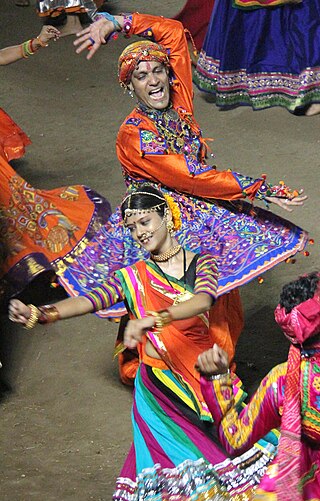
Garba is a form of Gujarati dance which originates from the state of Gujarat, India. The name is derived from the Sanskrit term Garbha. Many traditional garbas are performed around a centrally lit lamp or a picture or statue of the Hindu goddess Durga. Traditionally, it is performed during the nine-day Hindu festival Navaratri. Either the lamp or an image of the Goddess, Durga is placed in the middle of concentric rings as an object of veneration.

The Nyishi community is the largest ethnic group in Arunachal Pradesh in north-eastern India. The Nyishi language belongs to the Sino-Tibetan family, however, the origin is disputed. Their population of around 300,000 makes them the most populous tribe of Arunachal Pradesh, closely followed by the tribes of the Adi according to 2001 census.

The Adi people are one of the most populous groups of indigenous peoples in the Indian state of Arunachal Pradesh. A few thousand are also found in the Tibet Autonomous Region, where they are called the Lhoba together with some of the Nyishi people, Na people, Mishmi people and Tagin people.
Georgian mythology refers to the mythology of pre-Christian Georgians, an indigenous Caucasian ethnic group native to Georgia and the South Caucasus. The mythology of the Kartvelian peoples is believed by many scholars to have formed part of the religions of the kingdoms of Diauehi, Colchis and Iberia.
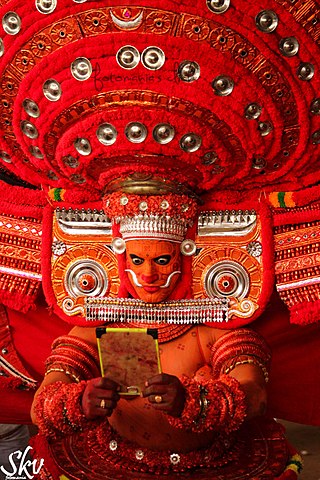
Theyyam is a Hindu religious ritual practiced in northern Kerala and some parts of Karnataka. Theyyam is also known as Kaḷiyāṭṭaṁ or Tiṟa. Theyyam consists of traditions, rituals and customs associated with temples and sacred groves of Malabar. The people of the region consider Theyyam itself as a channel to a god and they thus seek blessings from Theyyam.

Arunachal Pradesh is a state of India. It is known for dance music, which comes in many different styles. Dances from the region are often ritual in nature, but are also celebratory. They are mostly group dances, though others are restricted to men. Dances include popir, ponung and pasi kongki, rekham pada, aji lhamu and hiirii khaniing.
The Aos are a major Naga ethnic group native to Mokokchung District of Nagaland in Northeast India. Their main territory is from Tsüla (Dikhu) Valley in the east to Tsürang (Disai) Valley in the west in Mokokchung District.

In Northeastern India, the Miju Mishmi, also known as Kaman or Kammaan, are one of the three tribes of the Mishmi people of Tibet and Arunachal Pradesh. Members of this tribe are located in Anjaw and Lohit district. The Miju clans claim to have come from the Kachin country of Burma. They speak languages of the Midzu branch of Tibeto-Burman.

The Tagbanwa people are one of the oldest ethnic groups in the Philippines, and can be mainly found in the central and northern Palawan. Research has shown that the Tagbanwa are possible descendants of the Tabon Man, thus making them one of the original inhabitants of the Philippines. They are a brown-skinned, slim, and straight-haired ethnic group.
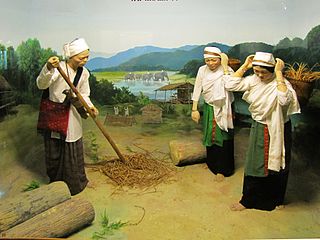
The Tai Khamti, also known as the Hkamti Shan or simply as Khamti, are a Tai ethnic group of India, China and Myanmar. The Tai-Khamti are followers of Theravada Buddhism. The Tai-Khamti have their own script for their language, known as 'Lik Tai', which originated from the Shan (Tai) script of Myanmar. Their mother tongue is known as Khamti language. It is a Tai language, closely related to Thai and Lao.

Hill Miri is previous name which is given by British but today's there is no exist name Hill Miri because they all are origin of Nyishi tribe so, they all are Nyishi tribe a native tribe of Arunachal Pradesh in Northeast India. They are spread in Upper Subansiri and Kamle districts. They speak a Tibeto-Burman language, but the exact origin of their language is disputed.

Karnataka has a variety of traditional arts, including folk dance and puppetry.

The village deities of Southern India are the numerous spirits and other beings venerated as part of the Dravidian folk tradition in villages throughout South India. These deities, mainly goddesses, are intimately associated with the well-being of the village, and can have either benevolent or violent tendencies. These deities are presently in various stages of syncretism or assimilation with mainstream Hindu traditions.
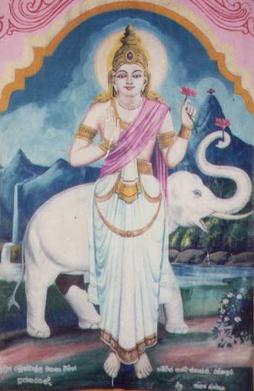
Saman is a deity, subject to local and indigenous belief and worship in Sri Lanka. The name Saman means "good minded". His character is of historical significance for the Sinhalese people and veneration especially to all the Buddhists. Maha Sumana Saman Deviraja is depicted crowned and bejeweled, holding a lotus flower in his right or left hand and accompanied by a white elephant.
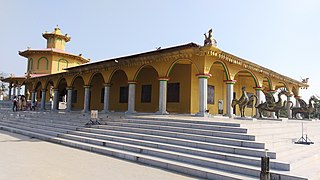
The Tai folk religion, Satsana Phi or Ban Phi is a form of ethnic animist religious belief practiced by Tai people. Tai folk religion was a dominant native religion of Tai people in Southeast Asia until the arrival of Buddhism. It's primarily based on worshipping deities called Phi, Khwan and Ancestors.

The di inferi or dii inferi were a shadowy collective of ancient Roman deities associated with death and the underworld. The epithet inferi is also given to the mysterious Manes, a collective of ancestral spirits. The most likely origin of the word Manes is from manus or manis, meaning "good" or "kindly," which was a euphemistic way to speak of the inferi so as to avert their potential to harm or cause fear.
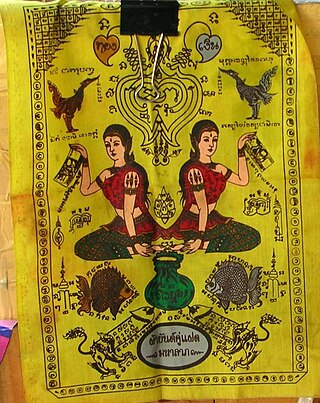
Thai folklore is a diverse set of mythology and traditional beliefs held by the Thai people. Most Thai folklore has a regional background for it originated in rural Thailand. With the passing of time, and through the influence of the media, large parts of Thai folklore have become interwoven with the wider popular Thai culture.
Mun or Munism is the traditional polytheistic, animist, shamanistic and syncretic religion of the Lepcha people. It predates the 7th century Lepcha conversion to Lamaistic Buddhism, and since that time, the Lepcha have practiced it together with Buddhism. Since the arrival of Christian missionaries in the nineteenth century, Mun traditions have been followed alongside that religion as well. The traditional religion permits incorporation of Buddha and Jesus Christ as deities, depending on household beliefs.
Si-Donyi Hilo is the major festival celebrated among the Tagin tribe of Arunachal Pradesh in North-eastern India. It is celebrated majorly in district headquarter Daporijo, in adjoining town Dumporijo and in Taliha, Siyum areas, also in state capital Itanagar, while in other places also it's being celebrated by Tagin community present there. The festival was first conceptualised in the year 1975 by Late Tatar Uli, who was the main pioneer in inception of Si-Donyi uyu. The other members who bore the responsibilities were Late Tadak Dulom and Popak Bage. The festival was celebrated in the same year under their guidance, and since then, the festival Si-donyi uyu has been celebrated by the Tagin tribe. The first priest who led the ritual was Dubi Nogam. Further the name Si-Donyi was suggested by Shri. Bingsa Kodak.
















